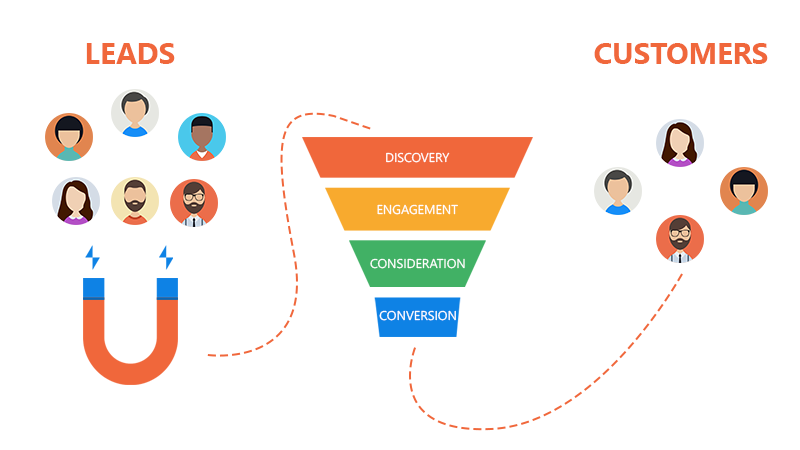For the first time about the funnel sales began talking in the middle of last century, but the universal pattern of customer behavior is relevant to this day. To understand the sales funnel is necessary for everyone who offers the audience their goods and services, whether it is an online socks store, a hairdresser for dogs or a fast food point. We tell how one of the basic algorithms of marketing works, and how to make the sales funnel work for you.
The Main Meaning Of The Sales Funnel Is In Four Words
- Attention = Warning
- Interest = Interest
- Desire = Desire
- Action = Action
According to the first letters of the formula, the sales funnel is often called the AIDA scheme or the AIDA principle. The four words reflect the path that the buyer passes from the first acquaintance with the goods to his purchase. The seller’s goal is to make sure that the product attracts attention, provokes interest, forms a desire and eventually was sold to the consumer.
At each stage of the sales funnel, sellers, marketers and advertising creators “work” with the audience, crushing the current needs of the buyer.
The AIDA scheme gave impetus to researching the desires of consumers and based on it, many modifications of the sales funnel appeared. From the point of view of the marketer’s work with the audience, the following version of the funnel is effective …
Working With The Proposal
➜ Getting cold contacts ➜ Forming interest in the proposal ➜ Persuasion ➜ Closing the deal.
1) At the stage of “Work with a proposal”, you create a USP (Unique Trade Proposal), which can potentially interest the client. The USP should be specific and unorganized. The formula “We have quality and cheap” does not work today. What will help attract the buyer: “For our bags we use a unique method of skin treatment for Ukraine. Find a bag of the same quality from other manufacturers, and we will give you our goods.” “Were you waiting for delivery? For every extra 10 minutes of waiting, we make a 5% discount on our pizza.”
2) At the stage of “Cold Contacts” you receive the initial information about the potential client and represent your company to him. A good option will be SMS-sending to Viber, which will tell about you and your USP potential customers who need your product.
3) At the stage of “Formation of interest to the proposal”, start communicating with the audience: remind yourself about yourself using various kinds of advertising, arrange tastings, days of “acquaintance with the goods” – jokes and promotions. The goal is to make sure that a person who needs a certain product bought it from you, not from a competitor.
4) At the stage of “Persuasion” or “work with objections” it is necessary to dispel all fears and doubts of the client: “Do you still think? Your neighbors have already bought! “,” Do you doubt the price? Find the goods cheaper, and we will refund your money. “
5) Stage “Closing a deal” means selling the goods to the client, which we have been “preparing” for a long time to buy. The goal of the seller is to make the client “fail” into the funnel and become an interested customer, or even better, a permanent customer.
Ideally adjusted work funnel sales, awareness of all the pros and cons of your advertising campaigns will increase the base of regular customers. This VIP-audience is considered the most valuable, because it does not need to “warm up” and “lure”, which means that you save time and money, resources so dear to your business.
Whichever version of the funnel you use, its principle boils down to three basic rules …
- When moving to the next stage of the funnel, most of the potential buyers are eliminated. Of the 1000 people interested in a real purchase will make a unit.
- “Bring” the consumer to buy need to consistently require action from an unprepared person is meaningless and inefficient.
- Each stage of the funnel requires its own principles of advertising and persuasion of the audience.
Why do you need to learn the funnel of your product sales?
- To know which audience at the initial stage of the funnel is needed specifically for your business to achieve results, i.e. sales.
- To understand how many potential customers are being eliminated at each stage.
- To develop effective advertising campaigns that will work with the actual needs of the client.
How to build a sales funnel?
If your business is presented to the Internet audience, a lot of services will help you build a sales funnel, including the familiar Google Analytics and Excel.
There is also an alternative view on the sales funnel: some marketers unreservedly trust this tool, others believe that the behavior of the modern buyer is not linear, and instead of a direct road to buying, a person “travels” through the funnel – can move back and forth, jump over the stages and go to competitors.
Even if the buyer’s “way” to the goods is not linear, he will somehow “go through” several funnel steps, even if he does not do it consistently, and this again confirms that the seller and the marketer must work with all the stages of the client’s behavior in the sales funnel and constantly take into account the needs and desires of the client.



